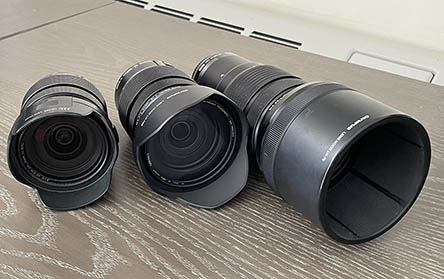My Current Photography Equipment
Although I hadn't updated this page for quite a while, I traded in one of the two Olympus OM-D E-M1 Mark II camera bodies for the Olympus OM-D E-M1 Mark III (a Mirrorless Micro Four Thirds System camera) in late 2020. Since I was happy with the new model and since I decided I no longer need to keep two bodies, I sold the remaining Mark II camera in early 2021. I don't seem to miss not having two camera bodies.
The two lenses I have been using are M.Zuiko ED 12-40mm f2.8 PRO (35mm equivalent focal lenth of 24-80mm) lens and M.Zuiko ED 40-150mm f2.8 PRO (80-300mm equivalent) telephoto lens. I recentlty purchase an M.Zuiko ED 12-100mm f4.0 PRO (24-200mm equivalent) zoom lens because I thought the wide focal range would be perfect as a travel lens - eliminating the need to carry two lenses. I am happy with the quality of this lens, and I'm looking forward to traveling with it. Here's a photo of the Olympus OM-D E-M1 Mark III with the 12-100mm zoom lens:
History of My Photography Equipment
Some of the older photos shown on this site were taken with the Olympus® C-2500L digital camera in the pre-DSLR era! I switched to the Olympus E-300, a DSLR, in December 2004, and then I continued chasing newer models... the E-510, E-3, and finally the E-5. Well, obviously I was wrong about the "finally" part, as I started chasing mirrorless Micro Four Thirds system cameras E-M5 in September 2012, E-M1 in May 2014, E-M1 Mark II in October 2018, and finally(?) E-M1 Mark III in November 2020.
Originally, I chose Olympus instead of the more mainstream Nikon or Canon because I liked some of the new technologies (such as live-view, in-body image stabilization, articulated LCD, electronic level gages) that Olympus was the first manufacturer to introduce. Also, the splash-proof and dust-proof build as well as the excellent lenses were important to me. Another reason is that the Micro Four Third System cameras and lenses are much more compact and lighter than the regular DSLRs, making them very convenient for travels and outings.
In-Body 5-Axis Image Stabilization
Despite being such a tiny camera, it matches (and in some instances exceeds) the specifications of the DSLRs. I especially appreciate the in-body 5-axis image stabilization (IS) system that is built into the camera body of the E-M1 series. While other cameras with a 2-axis IS can compensate only for vertical and horizontal shifts, the E-M1 series cameras can compensate for vertical and horizontal rotations and in-plane rotation in addition to the vertical and horizontal shifts. Here's a brief video clip by Olympus that describes the advanced technology:


